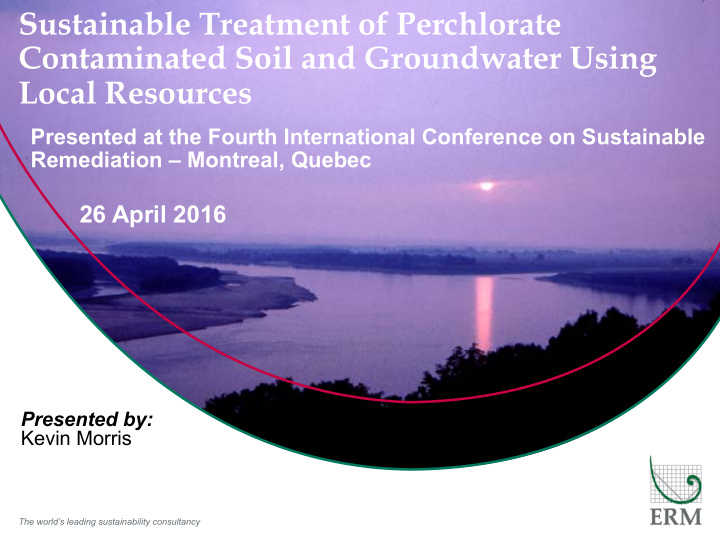



Sustainable Treatment of Perchlorate Contaminated Soil and Groundwater Using Local Resources Presented at the Fourth International Conference on Sustainable Remediation – Montreal, Quebec 26 April 2016 Presented by: Kevin Morris 5 June 2013 The world’s leading sustainability consultancy
Introduction ■ Site Overview ■ Problem ■ Green and Sustainable Remediation ■ Solution ■ Data ■ Conclusions The world’s leading sustainability consultancy
Site Overview Site located in Indiana within a mile of a large river system. Site has operated as a signal flare manufacturing facility since the late 1940’s. Manufacturing process includes handling and mixing of ammonium perchlorate. The world’s leading sustainability consultancy
Problem ■ Perchlorate releases over a 30 to 40 year period from a mixing building had impacted shallow soils and groundwater. ■ Perchlorate concentrations in soil beneath process building at 28,000 µ g/kg. ■ Perchlorate in groundwater at 19,000 µ g/L with a plume approaching the property boundary. ■ State agency requiring treatment of source area as well as mitigating migration of impacted groundwater. ■ Area is rural farmland, therefore remediation has to consider potential impacts to local community The world’s leading sustainability consultancy
Remediation Assessment ■ Remediation assessment included reviewing technologies based on effectiveness, implementability, cost and sustainability criteria. ■ Technologies considered included excavation, pump and treat and in situ bioremediation. ■ Stakeholders engaged during assessment included liability owner, regulatory agency and adjacent property owners. ■ In situ bioremediation determined to be the most effective, implementable and sustainable remedy agreed upon by all stakeholders assuming risk-based remedial goals and use of locally sourced materials. The world’s leading sustainability consultancy
Solution ■ Develop risk-based remedial goals that are protective of human health and the environment ■ Install injection biobarrier immediately downgradient of mixing building ■ Decontaminate and remove building and slab ■ Source area bioremediation beneath building via in situ bioreactor ■ Monitoring of soil and groundwater The world’s leading sustainability consultancy
Remedy Selection Via the 3 Pillars ■ Consider potential impacts to all stakeholders (including local community) ■ Consider economic impact to client ■ Consider environmental impact of the remedy while achieving risk-based remedial goals 7 The world’s leading sustainability consultancy
Bioreactors as Green & Sustainable Remediation ■ Relatively low energy usage for installations ■ Carbon/electron donor sourc was obtained locally on site ■ No O&M ■ Low carbon footprint compared to other more energy intensive remediation strategies such as excavation and pump and treat The world’s leading sustainability consultancy
Primary Components of Mulch Cellulose Hemicellulose Lignin The world’s leading sustainability consultancy
Perchlorate Reduction The world’s leading sustainability consultancy
Mixing Building The world’s leading sustainability consultancy
Building Demolition The world’s leading sustainability consultancy
Demolition Continued The world’s leading sustainability consultancy
Remediation ■ Installed injection biobarrier in September 2010 (15 injection points downgradient of mixing building) ■ Building decontaminated and demolished early October 2010 ■ Soils beneath former mixing building mixed with composted landscaping waste generated onsite down to a depth of 5 feet bgs ■ Drip feed system saturates vadose soils with 10,000 gallons of water over 24 hours ■ Area covered to prevent infiltration of oxygenated precipitation and maintain anoxic conditions. The world’s leading sustainability consultancy
In Situ Bioreactor The world’s leading sustainability consultancy
Treatment Completed The world’s leading sustainability consultancy
Perchlorate ( µ g/kg ) in Soil 1 - 2 feet bgs 30,000 25,000 20,000 15,000 10,000 5,000 0 The world’s leading sustainability consultancy
The world’s leading sustainability consultancy Perchlorate ( µ g/kg ) in Soil 5 – 6 feet bgs 10,000 15,000 20,000 25,000 30,000 5,000 0 1-Sep-09 1-Oct-09 1-Nov-09 1-Dec-09 1-Jan-10 1-Feb-10 1-Mar-10 1-Apr-10 1-May-10 1-Jun-10 1-Jul-10 1-Aug-10 1-Sep-10 1-Oct-10 1-Nov-10 1-Dec-10 1-Jan-11 1-Feb-11 1-Mar-11 1-Apr-11 1-May-11 1-Jun-11 1-Jul-11 1-Aug-11 1-Sep-11 1-Oct-11 1-Nov-11 1-Dec-11 1-Jan-12 1-Feb-12 1-Mar-12
Observations ■ Perchlorate in groundwater has been reduced by 90% ■ Perchlorate in soils were reduced by >90% within 2 years of remediation with no rebound ■ IDEM has agreed to no further action with covenant not to sue based on positive results ■ Redox conditions in groundwater continues to be reducing and are expected to allow for ongoing degradation of perchlorate The world’s leading sustainability consultancy
Conclusions ■ Remediation successful at achieving risk based concentrations in soils ■ Remediation effort also successfully mitigated migration of perchlorate from the site ■ Remediation effort consumed little energy (3 days of heavy equipment for demolition and soil mixing) ■ Remediation effort had no negative impact on local community The world’s leading sustainability consultancy
Questions? The world’s leading sustainability consultancy
Recommend
More recommend